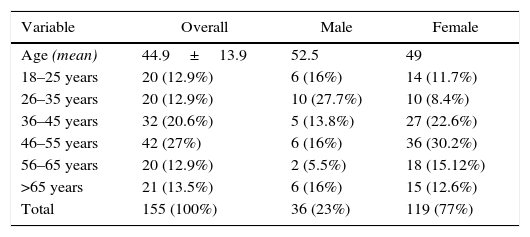Bone and joint disease has a high incidence and impact on the population. The bone scan is a diagnostic tool that provides important metabolic and clinical information, therefore the interpretation of the images by the nuclear medicine physician must be very precise. The isotopic distribution pattern in hands has not yet been described. For this reason a description is presented of common scintigraphic findings in adults without osteoarticular disease.
Materials and methodsA prospective analysis was conducted on 156 hands of patients whose bone scans met inclusion criteria. There were delineated regions of interest in the carpal, metacarpal, proximal, and distal interphalangeal joints of the second and third fingers of both hands. An analysis was made, including the total counts, means, and standard deviations. The cut-offs were selected using the normal distribution, which was defined as the cut at the 99th percentile of each variable. A semi-quantitative analysis was made of the images.
ResultsThe study included 36 men (23%) and 119 women (77%), and the mean age was 44.9±13.9. The mean total counts gradually decreased from proximal to distal in all age groups and in both genders in the following proportions: the activity in carpus was 4.4 fold more than the metacarpus; the metacarpus was 1.7 fold more than proximal interphalangeal joint; proximal interphalangeal joint was 1.4 fold more than distal one.
ConclusionsA scintigraphic pattern consisting of a gradual decrease from proximal to distal joints (degradation) was found in the hands of adults without bone and joint disease, regardless of gender and age.
La gammagrafia ósea es uno de los estudios más frecuentemente utilizados para el abordaje diagnóstico de la patología osteoarticular, sin embargo, no se conocen patrones claros de normalidad para algunos sitios anatómicos, llevando a tasas altas de variabilidad interobservador, como es el caso de la evaluación de las manos. No se encuentra en la literatura una descripción del patrón gammagráfico normal sobre manos, por lo cual pretendemos describir el patrón de captación más frecuente en una población adulta sin enfermedad osteoarticular.
Materiales y métodosSe hizo un análisis prospectivo de 156 gammagrafías óseas sobre manos que cumplieron el criterio de inclusión. Se delinearon regiones de interés en el carpo, metacarpo, articulaciones interfalángicas proximales y distales de los dedos índice y medio de ambas manos; se tomaron las cuentas totales, se analizaron promedios y desviación estándar, y se hizo análisis semicuantitativo de la imagen.
ResultadosSe incluyeron 36 hombres (23%) y 119 mujeres (77%), la edad media fue de 44.9±13.9. Los promedios de las cuentas totales disminuyeron progresivamente de proximal a distal en todos los grupos de edad y en ambos géneros, siguiendo la siguiente proporción: carpo 4.4 veces más que metacarpo; metacarpo 1.7 veces más que interfalángica proximal; interfalángica proximal 1.4 veces más que distal.
ConclusionesEn manos de pacientes adultos, sin enfermedad osteoarticular, sin distinción de género y edad, encontramos un patrón gammagráfico en «degradé» con mayor concentración isotópica en carpo, seguida del metacarpo y de las articulaciones interfalángicas proximales y distales.











